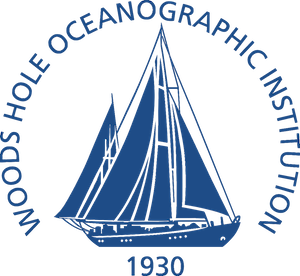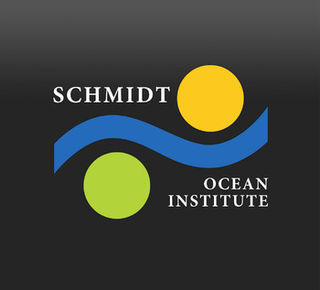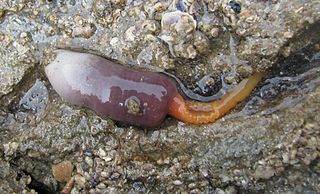
Marine biology is the scientific study of the biology of marine life, organisms in the sea. Given that in biology many phyla, families and genera have some species that live in the sea and others that live on land, marine biology classifies species based on the environment rather than on taxonomy.

The Woods Hole Oceanographic Institution is a private, nonprofit research and higher education facility dedicated to the study of marine science and engineering.

The National Oceanography Centre Southampton (NOCS) is a centre for research, teaching, and technology development in Ocean and Earth science. NOCS was created in 1995 jointly between the University of Southampton and the UK Natural Environment Research Council and is located within the port of Southampton at a purpose-built dockside campus with modern facilities. In 2010 the university and NERC components demerged, and the NERC-managed component became the National Oceanography Centre. The two components of NOCS continue close collaboration through the jointly run Graduate School, shared research facilities and laboratories, complementary research groups, and many joint research grants and publications. The university component “Ocean and Earth Science, National Oceanography Centre Southampton” (OES) is part of the Faculty of Environmental and Life Sciences, (FELS). It was ranked 46th in the world for Earth and Marine Sciences by the QS World University Rankings in 2019.
The National Oceanography Centre (NOC) is a marine science research and technology institution based on two sites in Southampton and Liverpool, United Kingdom. It is the UK’s largest institution for integrated sea level science, coastal and deep ocean research and technology development.

The Census of Marine Life was a 10-year, US $650 million scientific initiative, involving a global network of researchers in more than 80 nations, engaged to assess and explain the diversity, distribution, and abundance of life in the oceans. The world's first comprehensive Census of Marine Life — past, present, and future — was released in 2010 in London. Initially supported by funding from the Alfred P. Sloan Foundation, the project was successful in generating many times that initial investment in additional support and substantially increased the baselines of knowledge in often underexplored ocean realms, as well as engaging over 2,700 different researchers for the first time in a global collaborative community united in a common goal, and has been described as "one of the largest scientific collaborations ever conducted".

The Discovery Investigations were a series of scientific cruises and shore-based investigations into the biology of whales in the Southern Ocean. They were funded by the British Colonial Office and organised by the Discovery Committee in London, which was formed in 1918. They were intended to provide the scientific background to stock management of the commercial Antarctic whale fishery.
Scissurella manawatawhia is a species of minute sea snail, a marine gastropod mollusc in the family Scissurellidae.
Lissotesta conoidea is a species of minute sea snail, a marine gastropod mollusc, unassigned in the superfamily Seguenzioidea.
Lissotesta aupouria is a species of minute sea snail, a marine gastropod mollusc, unassigned in the superfamily Seguenzioidea.
Lissotestella caelata is a species of minute sea snail, a marine gastropod mollusc, unassigned in the superfamily Seguenzioidea.
Brookula annectens is a species of minute sea snail, a marine gastropod mollusc, unassigned in the superfamily Seguenzioidea.
Crosseola favosa is a species of minute sea snail or micromollusc, a marine gastropod mollusc in the family Conradiidae.
Crosseola intertexta is a species of minute sea snail or micromollusc, a marine gastropod mollusc in the family Conradiidae.
Larochea secunda is an extremely minute species of sea snail, a marine gastropod mollusc or micromollusc in the family Larocheidae.
Trochaclis antarctica is a species of sea snail, a marine gastropod mollusk in the family Ataphridae.
Acremodontina atypica is a species of sea snail, a marine gastropod mollusk in the family Trochaclididae, the false top snails.

Schmidt Ocean Institute (SOI) is a 501(c)(3) non-profit operating foundation established in March 2009 by Eric Schmidt and Wendy Schmidt. The Institute's goal is to advance innovative oceanographic research and discovery through technological advancement, collaborative research, outreach and education, and open sharing of information. SOI supports oceanographic research by providing collaborators with free ship time aboard their research vessel Falkor (too) and expert technical shipboard support. Collaborating researchers and institutions utilizing Falkor commit to openly share and communicate the outcomes of their research, including raw observations and data. Research proposals are reviewed through a peer-reviewed process and assessed based on their potential for technological innovation, oceanographic research, and overall impact. Since its inception in 2009, SOI has supported over 60 expeditions all around the globe.
Ronald Ian Currie FRSE CBE was a Scottish marine biologist. He was known generally as Ron Currie.
Maxmuelleria lankesteri is a species of spoon worm in the family Bonelliidae. It is found in the North Atlantic Ocean. It burrows into soft sediment on the seabed, mostly in deep water.

Thalassema is a genus of spoonworms in the subclass Echiura.






